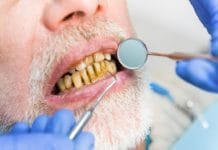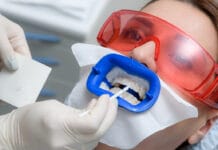Disclosure: We value transparency at Today’s RDH. This review is sponsored content from Tokuyama Dental America, Inc. as part of our sponsored partner program.
Your patient presents with a chief complaint of tooth sensitivity. After radiographs and a clinical examination, you’ve guessed it, gingival recession, exposed dentin, sensitivity, oh my! Unfortunately, dentinal hypersensitivity is a common issue for many of our patients. It is reported 57% of the general population experiences hypersensitivity. Dentinal hypersensitivity is even more prevalent in our periodontal patients, with a 60-98% reported frequency.1-4
In treating dentinal hypersensitivity, finding and addressing the cause is key. However, treatment or product recommendations to help alleviate discomfort is paramount. There are several product and treatment options to recommend to patients to help alleviate their discomfort, however, some are more effective than others.
Before we get to treatment options and my review of Tokuyama Dental’s Shield Force Plus®, here’s a quick review of dentinal hypersensitivity’s causes, differential diagnosis, treatment, and the hydrodynamic theory.
The Hydrodynamic Theory
No review of dentinal hypersensitivity would be complete without understanding Brännström’s hydrodynamic theory. Brännström’s hydrodynamic theory is the currently accepted theory which describes the mechanism in which pain associated with dentinal hypersensitivity occurs. This theory describes that stimuli, such as thermal, chemical, tactile, or evaporative, are transmitted to the pulp surface due to the movement of fluid within open dentinal tubules.5 Three types of nerve fibers are found within dentin, including A-delta, A-beta, and C-fibers.6 In this theory, the fluid movement caused by stimuli is thought to stimulate the myelinated, small A-delta fibers, which transmit the sensation of a localized, sharp pain to the brain.5
Though it varies from person to person, generally 18,000-21,000 tubules can be found in one square millimeter of dentin. Dentinal tubules are more numerous in the inner third layer than the outer third layer of dentin. The diameter of tubules varies between 2 and 4 micrometers.1
First described by Sir John Tomes in 1850, Tomes’ fibers extend into dentinal tubules from odontoblasts (odontoblastic process) that communicate with tooth pulp. Dentinal fluid within dentinal tubules accounts for about 22% of the total volume of dentin.2 On a weight basis, dentin is less mineralized than enamel (96% in weight) but more mineralized than bone or cementum (about 65% in weight).1
Causes of Gingival Recession Which Can Lead to Dentinal Hypersensitivity
If a patient presents with gingival recession and exposed root surfaces, dentinal hypersensitivity can be an obvious problem. With cementum being less calcified than enamel, stimuli more easily reach the underlying dentin, thus setting off the chain of effects of the hydrodynamic theory, which can lead to hypersensitivity pain. While alleviating pain is of utmost importance, the cause must be diagnosed and further, addressed and treated, to stop any further damage.
While not an in-depth list, here are some examples of gingival recession causes:
-Improper brushing technique: Using an aggressive scrubbing motion and/or using a toothbrush with medium or hard bristles.
-Improper home care/periodontal disease: Lack of proper biofilm removal can lead to periodontitis and tissue destruction.
-Excess consumption of acidic foods and beverages: Pathogenic bacteria favor an acidic environment.
-Parafunctional occlusal forces: Bruxism, clenching, chewing on pens, fingernails, or other objects, exert excess force on the periodontium which can lead to tissue destruction.
-Malocclusion: Like parafunctional occlusal forces, continued, excess force placed on the periodontium can lead to tissue destruction.
-Encroachment of biological width: “Bone loss and gingival recession occur as the body attempts to recreate room between the alveolar bone and the (restoration) margin to allow space for tissue reattachment.10”
-Piercings: The consistent gingival abrasion caused by certain oral piercings, such as a tongue or lip piercings, can eventually lead to gingival recession.10-12
Differential Diagnosis
Even if a patient presents with gingival recession, the pain they might be experiencing may not necessarily be caused by dentinal hypersensitivity. Here are some examples of differential diagnosis:
- Cracked tooth
- Fractured root
- Decay
- Recurrent decay
- Abscess
- Whitening
Treatment
The cause of a patient’s dentinal hypersensitivity determines the treatment. For instance, if a patient suffers from bruxism, a night-time appliance and assessment of airway may be called for. If tissue destruction due to active periodontal disease is the cause, the obvious treatment would be non-surgical periodontal therapy. As far as treatment to help alleviate sensitivity and pain due to exposed root surfaces, the goal is to either desensitize the nerves or recalcify the tissue to occlude dentinal tubules. There are a plethora of products and treatments to help with this. Some include:
- Sensitivity toothpaste containing potassium nitrate
- Rx fluoride toothpaste
- Fluoride rinse
- At-home fluoride trays
- Recalcifying pastes, such as ones containing arginine and calcium carbonate
- Fluoride varnish treatment
- In-office coronal polishing with a desensitizing paste
- Surgical interventions, such as a gingival graft
But wait, there’s more…
Before you immediately think of your “go-to” of fluoride varnish, using a pre-procedural desensitizing polish, or recommending a prescription strength fluoride or sensitivity toothpaste, have you thought about treating your patients’ dentinal hypersensitivity with a light-cured desensitizer? We use sealants to protect the occlusal surface of a tooth, essentially creating a sealed barrier against caries-causing bacteria, why not use the same concept to protect exposed root surfaces from stimuli that cause pain? Whether your doctor has not or will not provide you with a light-cured desensitizer product, or you’ve just never known it is a treatment option, I feel desensitizers are an underutilized treatment modality for our patients who experience dentinal hypersensitivity.
Tokuyama Shield Force Plus Review
About Tokuyama Shield Force Plus
Shield Force Plus offers two layers of protection with only one application. The first layer of protection is initial desensitization by blocking external stimuli, thus stopping fluid movement in dentinal tubules, by creating resin tags 50µm deep. Once light-cured, a 10µm layer creates long-term desensitization which, depending on the oral hygiene habits and diet of the patient, can last for up to three years. This layer also protects root surfaces.
Indications for use include treatment of dentinal hypersensitivity, reduction of abrasion and erosion of exposed cervical dentin, and alleviation and/or prevention of tooth sensitivity after tooth preparation for direct and indirect restorations.
Ease of Use
I found Shield Force Plus very easy to use. I didn’t find it messy or the product hard to work with at all. The treatments steps are:
- Clean the surface to be treated: Before application, I went through my normal routine of ultrasonic use, followed by hand instrumentation, and polishing with a non-fluoride prophy paste, to remove any biofilm, calculus, and stain. I used a fluoride-free prophy paste, as this is what the manufacturer instructions suggest.
- Dry the treatment area: I used air to dry the area, however, blotting with a 2×2 or cotton pellet would work too.
- Dispense product: I dispensed two drops of Shield Force Plus to the dappen dish provided with the kit. The liquid is green before being light-cured, so I could easily see the product in the white dappen dish. Considering I was only treating two smaller areas of recession, one drop would have been plenty.
- Apply: I applied the product to two areas of recession with the disposable applicator microbrush provided in the kit. I made sure to dry the area, dispense, and apply in a timely manner (within 5 minutes) so the desensitizer wouldn’t cure before I was ready to light-cure it. Because the treatment areas were so small, I couldn’t really tell the desensitizer was green on the treatment surface. I suspect if it were a larger treatment area, the green color would come in really handy to see where the product was or was not. Next, the instructions state to leave the desensitizer undisturbed for 10 seconds after applying. I didn’t have any problem with the product pooling, so I didn’t need to blot any excess, during this step.
- Air dry: After leaving the product undisturbed for around 10 seconds, I began air drying with light/weak air flow for 5 seconds, per the instructions. After the light/weak air flow, I gave the area a strong air flow for another 5 seconds. Essentially, how I accomplished this was blowing air from the air/water syringe outside the patient’s mouth, then I moved it closer to the treatment area. The instructions for use give the tip of controlling air flow using a mouth mirror to direct air flow, the “mirror deflection technique.” Again, I kept it simple and just moved the air/water syringe from far to near. Beginning with a light/weak air flow is important, and most often, the step not followed. The air should be applied weakly first to evaporate some of the solvents and water, thus making the product “firmer.” If you start off with strong air right away, you inadvertently displace the product from the intended area.
- Light-cure: I light-cured the treatment area for the recommended time of 10 seconds or more, keeping the light tip within a distance of 2mm from the treatment area. Because I treated only two teeth, I only needed to light-cure once. If treating a larger area, it is recommended to light cure in segments.
- Check for excess material: Lastly, I checked for any excess material in the gingival sulcus using an 11/12 explorer. I didn’t feel any, so there was no need for removal with a scaler. If I was using this near a tooth contact, I would probably also check the contact with floss for excess material.
Once the treatment area was cleaned, the process of treating with Shield Force Plus desensitizer took me less than one minute. Though not considered a sealant, I would consider Shield Force Plus easier and quicker to apply than a sealant; no etch, no occlusal checks, and no rinsing in between steps. Further, compared to some other desensitizers, no tissue isolation, waiting for extended periods of time before moving to the next treatment step, or rubbing, is needed.
Patient Comfort during Application
As a clinician, the last thing I want to do while treating a patient is hurt or cause discomfort to them. Because of this, one thing I like about Shield Force Plus is it’s not irritating to tissue, so there’s no need to isolate the treatment area. This not only saves time during treatment but assures me I won’t “burn” their tissue, for instance, as etchant or other desensitizers can. Of course, you want to avoid the gingiva during application, but if some accidentally makes contact, the patient won’t jump out of your chair. The patient reported no tissue irritation and was pleased with how fast the desensitizing treatment went.
Immediate Effectiveness
The patient I treated with Shield Force Plus had sensitivity to cold due to recession caused by an oral piercing. After completion of treatment, the patient grabbed her bottle of ice water to test for the immediate effectiveness of the desensitizer. When a big smile appeared on her face, I knew without her even saying a word, the immediate efficacy of Shield Force Plus.
Overall Impression
Overall, I’m pleased with Tokuyama Dental’s Shield Force Plus. It was quick and easy to apply, and my patient reported instant relief from her sensitivity. I felt the product goes a long way, as I didn’t need much to treat the areas of recession, and actually found I poured out more than I needed. At $0.66 per application, with 180 applications per bottle, the price to treat patients with this desensitizer with results lasting up to 3 years (dependent on the patient’s diet and homecare), can’t be beat. Because Shield Force Plus comes in a bottle, instead of packaged as single-dose, I feel there are far less product and packaging waste compared to other treatment options (think fluoride varnish).
Though not much of a downfall, Shield Force Plus does need to be stored at 32-50°F, so it does need to be stored in the refrigerator. While the temperature of the product does not affect the results of treatment, when the desensitizer is at room temperature it’s easier to dispense and the size of the drops are more uniform, reducing potential waste of the product.
One downfall to note is I couldn’t see the green tint of the desensitizer on the treatment surface, only in the white dappen dish. However, as mentioned before, perhaps it could be seen better on a larger treatment area. I don’t really see this as much as a problem though.
In Closing
With sensitivity or prescription fluoride toothpaste, or at-home fluoride trays, patient compliance can be an issue, and they aren’t always efficacious in relieving discomfort. This leads to our patients suffering from unneeded dentinal hypersensitivity, and anyone with sensitive teeth knows how uncomfortable this can be. I feel a desensitizer, like Tokuyama Dental’s Shield Force Plus, is something every hygienist should have in their dentinal hypersensitivity treatment toolbox.
Enjoy a special offer: Buy 1 Shield Force Plus, Get 1 Refill at No Charge
Promo Code: SKRDH
(Expiration: April 30, 2019, Promo code is limited to 1 time use)
Redeem your offer today by calling +1 (877) 378-3548 or visiting https://offers.tokuyama-us.com/sfpkarardh
For more information on Tokuyama Dental’s Shield Force Plus, click here. Check out the “Resources” tab toward the bottom of the page for some great desensitizer product comparisons with microscopic images!
References
- Chabanski, M.B., Gilliam, D.G., Bulman, I.S., Newman, H.N. Clinical Evaluation of Cervical Dentine Sensitivity in a Population of Patients Referred to a Specialist Periodontology Department: A Pilot Study. J Oral Rehabil. 1997; 24:666-72. Retrieved from https://www.ncbi.nlm.nih.gov/pubmed/9357747.
- Von Troil, B., Needleman, E. Sanz, M. A Systematic Review of the Prevalence of Root Sensitivity Following Periodontal Therapy. J Clin Periodontol. 2002; 29 (Suppl 3): 173-7. Retrieved from https://www.ncbi.nlm.nih.gov/pubmed/12787217.
- Orchardson, R. Gillam, D.G. Managing Dentin Hypersensitivity. J Am Dent Assoc. 2006; 137:990-8. Retrieved from https://www.ncbi.nlm.nih.gov/pubmed/16803826.
- Splieth, C.H., Tachou, A. Epidemiology of Dentin Hypersensitivity. Clin Oral Investig. 2013 Mar; 17(Suppl 1): 3–8. Retrieved from https://www.ncbi.nlm.nih.gov/pmc/articles/PMC3585833/.
- Chung, G., Jung, S.J., Oh, S.B. Cellular and Molecular Mechanisms of Dental Nociception. J Dent Res. 2013 Nov; 92(11):948-55. Retrieved from https://www.ncbi.nlm.nih.gov/pubmed/23955160.
- Martens, L.C. A Decision Tree for the Management of Exposed Cervical Dentin (ECD) and Dentin Hypersensitivity (DHS). Clinical Oral Investigations. 2013; 17(Suppl 1): 77-83. Retrieved from https://link.springer.com/article/10.1007/s00784-012-0898-7.
- Goldberg, M., Kulkarni, A.B., Young, M., Boskey A. Dentin: Structure, Composition and Mineralization: The Role of Dentin ECM in Dentin Formation and Mineralization. Frontiers in Bioscience (Elite Edition). 2011; 3:711-735. Retrieved from https://www.ncbi.nlm.nih.gov/pmc/articles/PMC3360947/.
- Davari, A. Ataei, E. Assarzadeh, H. Dentin Hypersensitivity: Etiology, Diagnosis and Treatment: A Literature Review. Journal of Dentistry. 2013; 14(3):136-145. Retrieved from https://www.ncbi.nlm.nih.gov/pmc/articles/PMC3927677/.
- Aishearya, M., Sivaram, G. Biological Width: Concept and Violation. SRM J Res Dent Sci. 2015; 6:250-6. Retrieved from: http://www.srmjrds.in/article.asp?issn=0976-433X;year=2015;volume=6;issue=4;spage=250;epage=256;aulast=Aishwarya.
- Plastargias, I., Sakellari, D. The Consequences of Tongue Piercing on Oral and Periodontal Tissues. ISRN Dentistry. 2014. Retrieved from https://www.hindawi.com/journals/isrn/2014/876510/.
- Plessas, A., Pepelassi, E. Dental and Periodontal Complications of Lip and Tongue Piercing: Prevalence and Influencing Factors. Australian Dental Journal. 2012; 57:71-78. Retrieved from https://www.ncbi.nlm.nih.gov/pubmed/23253840.
- Reynolds, M. Gingival Recession is Likely Associated with Tongue Piercings. J Evid Based Dent Pract. 2012; Sep; 12(3 Suppl): 145-6. Retrieved from https://onlinelibrary.wiley.com/doi/pdf/10.1111/j.1834-7819.2011.01647.x.












